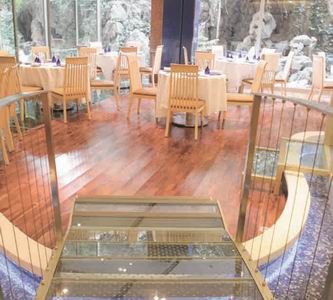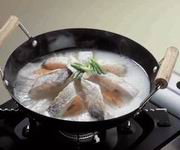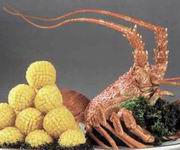Shanghai Daily news
In the days when Ningbo was a treaty port, it was known for two things:
bankers and seafood. Today, the city in Zhejiang Province is known for
entrepreneurs ¡ª and still, seafood, writes Tina Kanagaratnam.

The tables at People on the Water are set with seablue
platters and glasses.



From left: Fish in Soup, Duck and Bamboo Shoot Broth,
Shrimp Balls with Lobster.
That famous Ningbo seafood is the star of the show at People on the Water,
which opened in March at the Hilton Shanghai. The space that was once the cheap
and cheerful Shanghai Express has been transformed into a chic seafood
restaurant, where diners have to cross bridges over running streams and the
interior design is a stylish combination of glass, water and swimming
creatures.
Despite its renown, Ningbo seafood is relatively scarce in
Shanghai: to be authentically Ningbo-style, it must be jumping-fresh ¡ª a
difficult proposition, since many of the sea creatures used in the cuisine are
not found in Shanghai. But thanks to a partnership with Hantong Restaurant,
People on the Water is able to bring to Shanghai the freshness of real Ningbo
seafood. Hantong is the premier Ningbo seafood restaurant, and the volume of
their business allows them to ship quantities of live seafood to the Shanghai
restaurant each day.
¡°Freshness,¡± says Director of Operations Luc Bollard,
¡°is the name card of the restaurant.¡±
Indeed: a stroll around the 450-square
meter restaurant reveals a veritable aquarium of goodies, from clams and
scallops to lobsters, crabs, and an ocean¡¯s worth of fish. The produce changes
daily, depending on what¡¯s fresh and what is in season. It¡¯s like a market, and
that, says Bollard, is exactly the idea: customers pick out the seafood of their
choice, and then tell the staff how they would like it prepared. And if you¡¯re
clueless, don¡¯t worry: the staff, who are among the best-trained waitstaff in
the city, will recommend options.
The restaurant is ideal for those new to
this cuisine: each day, the chefs (there are 30 of them, all from Ningbo)
prepare a sample of each of the cold dishes and desserts the restaurant serves,
all 150 and more of them. The dishes are laid out in a mouth-watering array, and
all the diner has to do is point and choose.
Tables are set with sea-blue
platters, shaped like lily pads, blue glasses and blue vinegar dishes. (Mild
vinegar, along with preserved vegetables and seafood, is a hallmark of Ningbo
cuisine.) Starters include Ningbo-style raw crab, marinated in rice wine and
served with vinegar, which has a strong, but not unpleasant, flavor. Sweet,
plump red dates, a classic Shanghai dish, tastes like it should be dessert,
while the salted fish is nicely enhanced with a sweet-sour sauce. The sweet-sour
sauce also features in the big chunks of fried taro, crisp on the outside and
soft on the inside, as are the crispy, breaded shrimp balls - another classic -
which arrive piping hot.
Because the seafood is so fresh, it needs only the
mildest of enhancements: the meaty, sweet Mandarin fish is steamed with ginger
and scallions; the ¡°sea mushrooms¡± are quickly panfried with a little salt.
¡°This is not fancy food,¡± explains Bollard.
¡°The ingredients are
down-toearth, simple, and quickly cooked ¡ª homestyle, really.¡± Seafood so fresh
you can taste it ¡ª simple, yes, ¡ª but the sort of simplicity that is
luxurious.



